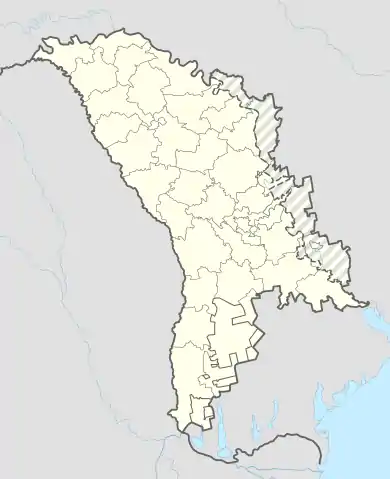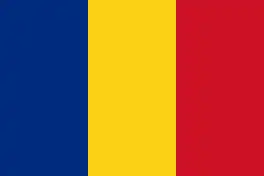Edineț | |
|---|---|
 Flag  Coat of arms | |
 Edineț Location in Moldova | |
| Coordinates: 48°10′N 27°19′E / 48.167°N 27.317°E | |
| Country | Moldova |
| District | Edineț District |
| Established | 1431 |
| Government | |
| • Mayor | Constantin Cojocari (LOC) |
| Area | |
| • Total | 2.2 sq mi (5.7 km2) |
| Elevation | 758 ft (231 m) |
| Population | |
| • Total | 15,520 |
| • Density | 7,100/sq mi (2,700/km2) |
| Time zone | UTC+2 (EET) |
| • Summer (DST) | UTC+3 (EEST) |
| Postal code | MD-4601 |
| Area code | +373 246 |
| Climate | Dfb |
Edineț (Romanian pronunciation: [ˈedinet͡s]) is a municipality[2] in northern Moldova. It is the administrative center of the eponymous district. The town is located 201 km north of the national capital, Chișinău. It is located at 48°10′N 27°19′E / 48.167°N 27.317°E. The town administers two suburban villages, Alexăndreni and Gordineștii Noi. The population at the 2004 census was 17,292 inhabitants, including 15,624 in the town itself.
To the north of the town is the commune Hlinaia (Glina-Mare); to the south, the town of Cupcini; to the east, the commune of Ruseni; and to the west, the suburb of Alexăndreni.
History
The first known written mention of the locality is in a document from July 15, 1431, in which the Prince of Moldavia Alexandru cel Bun offered to Ivan Cupcici "14 villages with their old domains and empty land to found new villages and an apiary". According to the document, the old name of Edineț was Viadineți, possibly meaning "little Viadins". A document dating August 18, 1690, given by Prince Constantin Movilă to Cozma Pop, mentions the village as Iadineți. The name Edineț is documented since 1663, and is still used today. Between 1918–1940, the alternative spellings Edineți and Edinița were sometimes used.
In 1812, the eastern part of Moldavia was annexed by the Russian Empire and became known as Governorate of Bessarabia.
Bessarabia proclaimed independence in January 1918 as the Moldavian Democratic Republic. In April 1918, Bessarabia proclaimed union with Romania.
At the 1930 census, there were three separately administered localities: Edineți-Târg (literally "Edineți-Fair"), population 5,910, Edineți-Sat ("Edineți-Village"), population 5,260, part of Plasa Briceni of the Hotin County,[3] and Alexăndrenii-Noi, population 1,083, part of Plasa Rășcani of the Bălți County.[4]
Between the two World Wars there was a Zionist Tarbut school in the town.
In 1940, the Soviet Union, with the consent of the Nazi Germany occupied Bessarabia, created the Moldavian SSR, closing privately owned businesses and religious schools.
.jpg.webp)
A year later, the Romanian Army, now allied with Nazi Germany, drove the Soviets out and recovered Bessarabia. German and Romanian troops entered Edineț on July 5, 1941. Before that, some of the Bessarabian Jews of Edineț had already fled. Within two days, several hundred Jews were murdered by units of Einsatzkommando D and Romanian gendarmes, assisted by some civilians. Within the first two weeks, Romanian soldiers had killed about 1,000 Jews out of 5,000 living in the town.[5] Many women and young girls were raped; some of them committed suicide. The victims were buried in three large ditches, then the Jewish gravediggers who had interred the bodies were in turn murdered and buried on the same spot. In the middle of August a ghetto was set up. Surviving Jews of Edineț, and others from different places in the north of Bessarabia and from Bukovina, were interned. In September there were about 12,000 Jews in the ghetto, crammed into a small area, suffering from malnutrition and disease. Dozens of people died every day, succumbing to disease, cold weather, hunger, or thirst. On September 16, 1941, all the remaining Jews were deported to Transnistria, where the majority of them died. By 1944 only a few managed to survive. The few dozen families still alive at the end of the war settled either in Czernovitz or moved to Israel. Only a handful chose to return to Edineț.
In 1944, the Soviets re-conquered Bessarabia and re-established the Moldavian SSR. During the Soviet time, the town was also known in the Russified versions Yedintsy and Yedintzi and in Yiddish as Yedinets or Eydinets.
In 1960s, the Jewish population was estimated at about 200. There was no synagogue, although the Jewish cemetery still existed.
Following the dissolution of the Soviet Union in 1991, Moldova became an independent country.
Culture
Edineț has a Natural History Museum, and a famous Museum of National Craftsmen, whose collection has many original folk objects and works.
Demographics
According to the 2014 census, the population of Edineț amounted to 15,520 inhabitants, a decrease compared to the previous census in 2004, when 17,292 inhabitants were registered. Of these, 7,211 were men and 8,309 were women.[6]
Footnotes:
* There is an ongoing controversy regarding the ethnic identification of Moldovans and Romanians.
* Moldovan language is one of the two local names for the Romanian language in Moldova. In 2013, the Constitutional Court of Moldova interpreted that Article 13 of the constitution is superseded by the Declaration of Independence,[9] thus giving official status to the name Romanian.[10][11]
| Ethnic composition (1930 Census) | |||||||
| Ethnic group | |||||||
| Edineți-Târg | Edineți-Sat | Alexăndrenii-Noi | |||||
| Romanians | 194 | 2,183 | 1,082 | ||||
| Jews | 5,341 | 398 | – | ||||
| Russians | 344 | 2,214 | 1 | ||||
| Ruthenians (Ukrainians) | 14 | 353 | – | ||||
| Romani | – | 55 | – | ||||
| Bulgarians | 1 | 1 | – | ||||
| Poles | 14 | 28 | – | ||||
| Germans | – | 3 | – | ||||
| Albanians | 1 | – | – | ||||
| Hungarians | – | 1 | – | ||||
| others | 1 | 24 | – | ||||
| Total | 5,910 | 5,260 | 1,083 | ||||
| Linguistic composition (1930 Census) | ||||
| Language | ||||
| Edineți-Târg | Edineți-Sat | Alexăndrenii-Noi | ||
| Romanian | 183 | 2,209 | 1,082 | |
| Yiddish | 5,328 | 401 | – | |
| Russian | 375 | 2,360 | 1 | |
| Ukrainian | 9 | 282 | – | |
| Polish | 11 | 7 | – | |
| German | 2 | 1 | – | |
| Bulgarian | 1 | – | – | |
| other | 1 | – | – | |
| Total | 5,910 | 5,260 | 1,083 | |
Media
- Radio Chișinău 104.6 FM
- Jurnal FM 107.9 MHz
- Radio Sanatatea
Notable people
International relations
Twin towns – Sister cities
Edineț is twinned with:
 Râmnicu Sărat, Romania
Râmnicu Sărat, Romania
References
- ↑ Results of Population and Housing Census in the Republic of Moldova in 2014: "Characteristics - Population (population by communes, religion, citizenship)" (XLS). National Bureau of Statistics of the Republic of Moldova. 2017. Retrieved May 1, 2017.
- ↑ LEGE Nr. 248 din 03.11.2016 pentru modificarea și completarea Legii nr. 764-XV din 27 decembrie 2001 privind organizarea administrativ-teritorială a Republicii Moldova (in Romanian)
- ↑ 1930 Romanian Census results for Hotin County Archived July 20, 2011, at the Wayback Machine
- ↑ 1930 Romanian Census results for Bălţi County Archived July 20, 2011, at the Wayback Machine
- ↑ "Execution Sites of Jewish Victims Investigated by Yahad-In Unum". Yahad Map. Retrieved December 22, 2014.
- ↑ "2014 Moldova Census of Population and Housing". National Bureau of Statistics of the Republic of Moldova. (in Romanian, Russian, and English)
- ↑ "2014 Moldova Census of Population and Housing". National Bureau of Statistics of the Republic of Moldova. (in Romanian, Russian, and English)
- ↑ "2014 Moldova Census of Population and Housing". National Bureau of Statistics of the Republic of Moldova. (in Romanian, Russian, and English)
- ↑ "Hotărâre Nr. 36 din 05.12.2013 privind interpretarea articolului 13 alin. (1) din Constituție în corelație cu Preambulul Constituției și Declarația de Independență a Republicii Moldova (Sesizările nr. 8b/2013 și 41b/2013)" (in Romanian). Constitutional Court of Moldova. Archived from the original on March 5, 2016. Retrieved December 20, 2013.
124. ... Prin urmare, Curtea consideră că prevederea conținută în Declarația de Independență referitoare la limba română ca limbă de stat a Republicii Moldova prevalează asupra prevederii referitoare la limba moldovenească conținute în articolul 13 al Constituției.
[124. ... Therefore, the Court considers that the provision contained in the Declaration of Independence regarding the Romanian language as the state language of the Republic of Moldova prevails over the provision regarding the Moldovan language contained in Article 13 of the Constitution.] - ↑ "Moldovan court rules official language is 'Romanian', replacing Soviet-flavored 'Moldovan'". Fox News. Associated Press. December 5, 2013. Archived from the original on December 9, 2013. Retrieved December 7, 2013.
- ↑ "Chisinau Recognizes Romanian As Official Language". Radio Free Europe/Radio Liberty. December 5, 2013. Archived from the original on September 23, 2016. Retrieved March 11, 2014.
Further reading
- Yedintsy (p. 425) at Miriam Weiner's Routes to Roots Foundation
.jpg.webp)
.jpg.webp)
.jpg.webp)
.jpg.webp)
.jpg.webp)
.jpg.webp)

